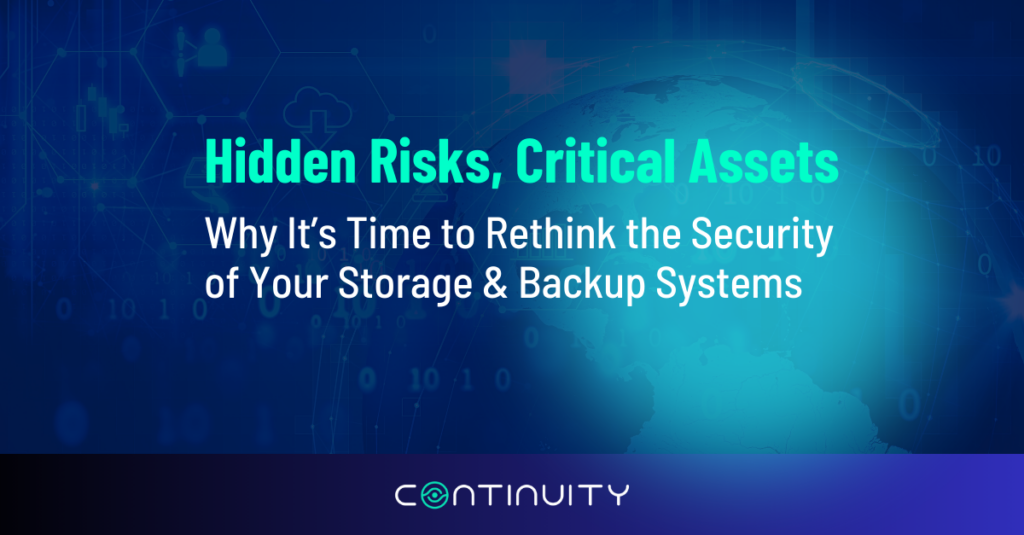
Hidden Risks, Critical Assets: Why It’s Time to Rethink the Security of Your Storage & Backup Systems
About Continuity™
StorageGuard - by Continuity™ - is the ONLY Security Posture Management solution for Storage & Backups, helping to ensure these systems are securely configured, and compliant with industry & security standards.
When we talk about cybersecurity, storage and backup systems rarely get the spotlight. But in today’s evolving threat landscape, ignoring them can be catastrophic. Recent cyberattacks have shown that these foundational components — once seen as technical backend concerns — are now front-line targets. It’s time to put your storage and backups at the center of your Security Posture Management strategy.
Real-World Wake-Up Calls: The Storage & Backup Attack Surge
Cybercriminals have started to specifically target storage and backup infrastructure — and the fallout has been devastating.
- DarkSide ransomware actors described how they disable organizations by deleting a single backup index file, instantly rendering all recovery data inaccessible.
- In a high-profile Russia–Ukraine cyber incident, attackers destroyed over 4,000 servers, crippling Ukraine’s largest mobile provider by taking out its storage and backup systems just hours before President Zelenskyy met with President Biden.
- Let’s Secure Insurance suffered a breach after failing to properly secure its storage systems — a reminder that even traditional, risk-aware industries aren’t immune.
These are not isolated cases. This is a trend. And your storage and backup systems could be next.
Industry Standards Are Raising the Bar
It’s not just attackers taking notice. Regulators, compliance bodies, and cyber insurers are explicitly calling out the need to harden storage and backup systems:
- PCI DSS 4.0 includes a recent requirement to perform internal vulnerability scans via authenticated scanning.
- NIST SP 800-209 and ISO/IEC 27040 provide detailed guidance on securing storage infrastructure — and are quickly becoming must-follow references.
- Cyber insurers are raising premiums and increasing scrutiny of storage & backup controls – requiring evidence of segmentation, access control, and patch discipline.
- Gartner (2024 Cyberstorage Insight) urges organizations to “harden existing unstructured data storage solutions by leveraging storage vulnerability management tools and following vendor best practices.”
Why Storage & Backup Security Matters More Than Ever
From ransomware to insider threats, if your primary storage is compromised, hundreds or thousands of workloads — databases, containers, VMs — can go down in a flash.
Worse still, if your backup systems are compromised, there’s no Plan B. No way to recover. You’re out of options.
On average, each enterprise storage or backup device has 10 vulnerabilities, including 5 critical or high-severity ones. Yet most organizations have limited visibility into these weaknesses.
Three Key Steps to Fortify Your Storage & Backup Systems
1. Use Specialized Vulnerability Scanners
Your traditional Vulnerability Management tool (e.g. Tenable, Qualys, and Rapid7) won’t cut it. Use a vulnerability scanner that’s:
- Tailored for storage & backup infrastructure
- Capable of authenticated & unauthenticated scans
- Backed by a robust, up-to-date vulnerability database for storage & backups
- Able to flag upcoming end-of-support deadlines
2. Build a Secure Configuration Baseline
Define secure settings per product (e.g. Dell, Pure, Hitachi Vantara, NetApp, Rubrik, Cohesity) – and ensure they’re reviewed and refreshed regularly. A secure baseline includes both system-level and security controls that reflect vendor guidance and real-world attack patterns.
3. Perform a Gap Assessment
| # | Question | |
| Vulnerability and Patch Management | ||
| 1 | Ability to scan our Storage & Backup appliances? | |
| 2 | Authenticated scan for vulnerabilities and missing patches ? Runs Platform-Specific APIs / Commands? | |
| 3 | Automatic detection and remediation validation? (Patch / mitigating configuration) | |
| 4 | Solid inventory of all Storage & Backup arrays, appliances, nodes & software? | |
| Security Baseline, Configuration Compliance and Drift Management | ||
| 5 | Defined target system & security settings for Storage & Backup Platforms? | |
| 6 | Repeatable way to assess security misconfigurations? Continuous drift detection? | |
| Knowledge | ||
| 7 | Expertise in securing Storage & Backup technologies? | |
| 8 | Researched security best practices & hardening instructions for Storage & Backup Platforms? | |
Gap assessments surface weak spots you didn’t know existed.
What a Complete Storage & Backup Security Program Looks Like
A well-architected Security Posture Management plan for storage and backups includes:
- Vulnerability management tailored to the environment
- Secure configuration enforcement
- Real-time anomaly detection (block and file-level)
- Compliance mapping (PCI DSS, NIST, ISO, HIPAA, etc.)
- Integration with tools like ServiceNow, Qualys/Rapid7/Tenable, CyberArk, CyberSense, Varonis, and others
Final Thoughts
Storage and backup systems are your organization’s most critical — and ironically most overlooked — assets. They deserve the same security rigor as endpoints, networks, and apps.
With attacks intensifying and standards evolving, now is the time to prioritize vulnerability management, configuration hardening, and resilience assessments for your storage and backup infrastructure.
Talk To An Expert
It’s time to automate the secure configuration of your storage & backup systems.